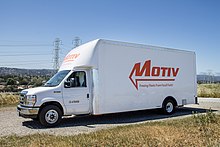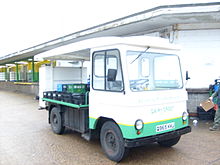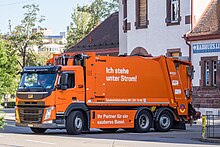Electric truck
Electric trucks have serviced niche applications like milk floats, pushback tugs and forklifts for over a hundred years, typically using lead-acid batteries, but the rapid development of lighter and more energy-dense battery chemistries in the twenty-first century has broadened the range of applicability of electric propulsion to trucks in many more roles.
[1][2] According to the United States Department of Energy, the average cost per kWh capacity of battery packs for trucks fell from $500 in 2013 to $200 in 2019, and still further to $137 in 2020, with some vehicles under $100 for the first time.
A few electric general lorries prototypes or produced by small manufacturers, and often converted Diesel units, have been built until the 2000s.
From 2018, other major manufacturers including MAN, Mercedes-Benz and DAF began deliveries of prototypes or pre-production heavy-duty units to companies for real-world testing.
These Motiv options have a variety of body styles from conventional manufacturers including Morgan Olson,[13] Utilimaster,[14] and Rockport.
While many large automotive companies have made announcements about their intent to enter this market with showcases of their prototypes,[17] the majority of vehicles on the road today are from smaller manufacturers.
In the late 1990s and early 2000s, Chevrolet produced a small series of an electric S-10 pickup truck while Ford made a certain number of Ranger EVs.
In early 2009, Phoenix Motorcars introduced a test fleet of their all-electric SUT (Sports Utility Truck) to Maui.
[18] A Canadian company named Ecotuned offers an all-electric conversion of the Ford F-150; these vehicles are used by the electricity provider Hydro Quebec and Montreal Airport.
GSC Logistics demonstrated this by hauling cargo from the Port of Oakland, over the Altamont Pass, to Tracy, CA and back.
[21] Volvo, DAF, MAN, Freightliner plan to begin series production of electric articulated lorries between 2019 and 2020.
[24] The Port of Los Angeles and South Coast Air Quality Management District have demonstrated a short-range heavy-duty all-electric truck capable of hauling a fully loaded 40-foot (12.2 m) cargo container.
The current design is capable of pulling a 60,000 lb (27,000 kg) cargo container at speeds up to 10 mph (16 km/h) and has a range of between 30 and 60 miles (48 and 97 km).
[27] As mass production begins, the cost might eventually be comparable to diesel vehicles and with improvement in batteries the limited range of the electric truck might be a non-issue.
These and other factors such as ease of driver training resulted in Birmingham City Council opting to use electric dustcarts to start replacing its horse driven carts in 1918.
[41] Traditional garbage trucks have extremely high fuel consumption, higher than American 18 wheelers achieve on most routes.
[42][43] Solar panels on tractors typically support the HVAC system, or power devices used by the driver (hotel loads).
[44][45] Heemskerk Dairy combines vehicle-integrated photovoltaics with electric forklifts, to ensure quiet operations that keep livestock relaxed.
[46] In 2022, DHL announced that installation of solar panels on the roofs of 67 of its trucks would result in cost savings and a 100 kg/year reduction in carbon emissions per vehicle.
[48] The presence of diesel exhaust in the air increases the risk of asthma, heart attacks and strokes, lung cancer, and early death.
[56] In 2023, the U.S. Environmental Protection Agency gave the legal authority to California to require that half of all heavy-duty truck sales be fully electric by 2035.











